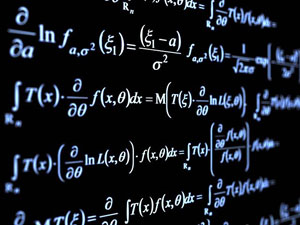Contents hide1. Equality of Matrices
Two matrices
and
of the same order [i.e. equal numbers of rows and columns] are equal if and only if
.
2. Addition of Matrices
If
and
have the same order we define the sum of
and
as
.
Note that the communicative and associative laws for addition are satisfied by matrices, i.e. for any matrices
of the same order
3. Subtraction of Matrices
If
,
have the same order, we define the difference of
and
as
.
4. Multiplication of a Matrix by a Number
If
and
is any number or scalar, we define the product of
by
as
.
5. Multiplication of Matrices
If
is an
matrix while
is an
matrix, then we define the product
or
as the matrix
where
and where
is of order
.
Note that in general
, i.e. the communicative law for multiplication of matrices is not satisfied in general. However, the associative and distributive laws are satisfied, i.e.
A matrix
can be multiplied by itself if and only if it is a square matrix. The product
can in such case be written
. Similarly we define powers of a square matrix, i.e.
, etc.
6. Transpose of a Matrix
If we interchange rows and columns of a matrix
, the resulting matrix is called the transpose of
and is denoted by
. In symbols, if
then
.
We can prove that
7. Symmetric and Skew-Symmetric matrices
A square matrix
is called symmetric if
and skew-symmetric if
.
Any real square matrix [i.e. one having only real elements] can always be expressed as the sum of a real symmetric matrix and a real skew-symmetric matrix.
8. Complex Conjugate of a Matrix
If all elements
of a matrix
are replaced by their complex conjugates
, the matrix obtained is called the complex conjugate of
and is denoted by
.
9. Hermitian and Skew-Hermitian Matrices
A square matrix
which is the same as the complex conjugate of its transpose, i.e. if
, is called Hermitian. If
, then
is called skew-Hermitian. If
is real these reduce to symmetric and skew-symmetric matrices respectively.
10. Principal Diagonal and Trace of a Matrix
If
is a square matrix, then the diagonal which contains all elements
for which
is called the principal or main diagonal and the sum of all elements is called trace of
.
A matrix for which
when
is called diagonal matrix.
11. Unit Matrix
A square matrix in which all elements of the principal diagonal are equal to 1 while all other elements are zero is called the unit matrix and is denoted by
. An important property of
is that
The unit matrix plays a role in matrix algebra similar to that played by the number one in ordinary algebra.
12. Zero or Null matrix
A matrix whose elements are all equal to zero is called the null or zero matrix and is often denoted by
or symply 0. For any matrix
having the same order as 0 we have
Also if
and 0 are square matrices, then
The zero matrix plays a role in matrix algebra similar to that played by the number zero of ordinary algebra.
Some special definitions and operations involving matrices

